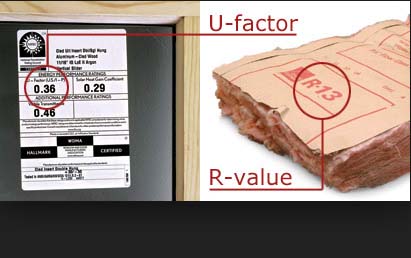Shopping for replacement windows can be a bit daunting and even comparing replacement window ratings can be much more difficult than you might expect. Why is this? Because companies don’t want you to make sense of it. The companies that offer the “best windows ever produced by mankind” know full well that their windows aren’t really any better than other windows offered by hundreds of other local companies.
How then can you sort through all of the nonsense to get to the real info? First you need to understand the ratings. U-Factor and R-Value are common ratings used to measure efficiency. You may be familiar with R-Values as they’re used in insulation.
Simply put the U-Factor is the inverse of the R-Value. For example a windows is an R-4 then the U-Factor is 1/4 or 0.25. Of course if it were that easy everyone would understand it and there would be no need for this post.
Here’s a little history. Back in the day (say before 2008) windows were commonly sold based on R-Values. These are nice round numbers that are easy for consumers to understand. A very common sales pitch included prices for windows with an R-4, R-7 and R-10. The higher the R-Value the better so the R-10 cost the most and the R-4 cost the least. That pitch was very effective due to its simplicity. It was easy to teach the salesperson and it was easy for the customer to digest. The problem was that it wasn’t very accurate.
In 2008 the federal government came out with expanded tax credits for replacement windows that were based on specific U-Factors and SHGC ratings. Intently the R4-7-10 pitch went out the window as folks were now concerned with the 0.30 U-Factor required to qualify for tax savings.
Why did the feds base the tax credits on U-Factors?
We know a lot of things the government does don’t make much sense, but this one did. U-Factors as determined by the National Fenestration Ratings Council (NFRC) are a measure of the entire window. They take into account the frame, the glass, any additional options and they provide a clear measure of the effectiveness of the product. This is why the U-Factor remains the best measure of efficiency of a window long after the federal tax credits have gone away.
Why do some companies still use R-Values?
Because they don’t want to offer you an easy comparison. R-Values as given out by window salespeople are often measures of just the center of the glass of the window. This is the most efficient part of any window as it doesn’t take into account any spacers or frames or other parts. Of course you’re buying an entire window not just the glass. Looking at just the glass measurements doesn’t do you any good.
We routinely see companies advertising R-10 windows as being special, which is just silly. To accurately describe this an R-10 window would have a U-Factor of 1/10 or 0.10. Do these windows have U-Factors of 0.10? They do not. Why don’t the numbers add up? Because they company was trying to be tricky with the ratings.
So know you know that just about any window company offering R-Values is not being clear about the ratings, it’s important to remember that the Department of Energy put out an R5 volume purchase program a few years back. The ratings in this case were accurate. This was setup to drive down the costs of windows that exceeded the previous standards. It hasn’t been much of a success just yet, and we’ll have another post on the subject.
So how do you sort through all of this to find a great deal?
The easy way is to look at the NFRC ratings for the products you’re considering. Don’t take some R-Value from the salesperson. Just ask them for the real NFRC ratings and don’t take any excuses as to why the company can’t or won’t provide them.
Once you have that, you’ll be able to compare the options directly and you’ll be on your way to cutting through all of the clutter to find yourself a great deal.
You can find more info on replacement window ratings here and you can find detailed replacement reviews here.
Have fun!


Puzzled. I viewed the Energy Star ratings and found that a double pane window with a 29 U rating a lo-E272 would not qualify, while the same window with a lo-E 180 rating would qualify due to the higher SHGC rating? Why would one pay more, to get a window that wouldn’t be considered to meet the Energy Star rating?
You’re probably in the Northern climate zone. In colder climates you send more money heating your home in the winter than cooling it in the summer. Windows with a higher SHGC rating will allow more heat into the house in the winter which reduces your heating costs. People sometimes think lower ratings are always better, but that’s not always the case.
It’s good to know that R and U-values both measure efficiency, but the U-value is the inverse of the R. I just learned that my parents want to have new vinyl windows installed for the cottage vacation home they’re almost finished purchasing. Thanks for teaching me this info so I can help them choose the perfect windows to have installed soon!